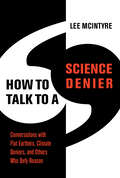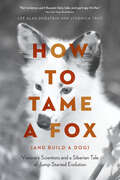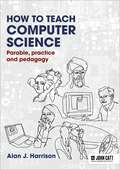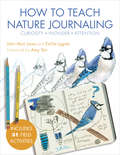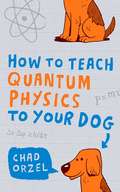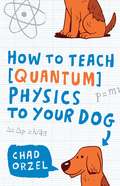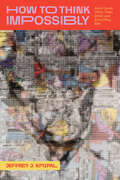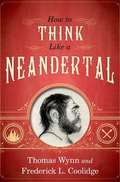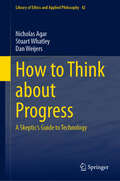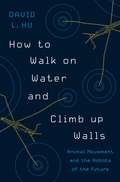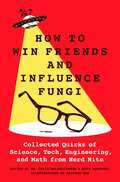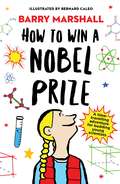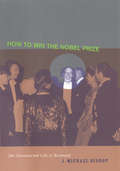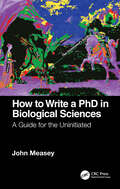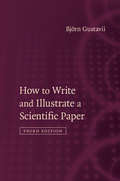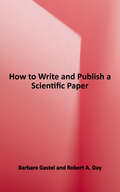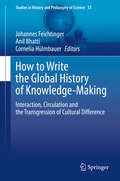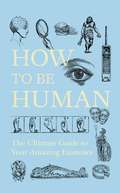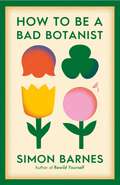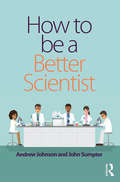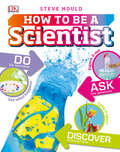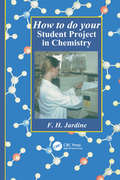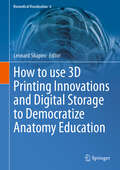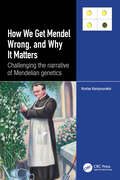- Table View
- List View
How to Talk to a Science Denier: Conversations with Flat Earthers, Climate Deniers, and Others Who Defy Reason
by Lee McIntyreCan we change the minds of science deniers? Encounters with flat earthers, anti-vaxxers, coronavirus truthers, and others."Climate change is a hoax--and so is coronavirus." "Vaccines are bad for you." These days, many of our fellow citizens reject scientific expertise and prefer ideology to facts. They are not merely uninformed--they are misinformed. They cite cherry-picked evidence, rely on fake experts, and believe conspiracy theories. How can we convince such people otherwise? How can we get them to change their minds and accept the facts when they don't believe in facts? In this book, Lee McIntyre shows that anyone can fight back against science deniers, and argues that it's important to do so. Science denial can kill.Drawing on his own experience--including a visit to a Flat Earth convention--as well as academic research, McIntyre outlines the common themes of science denialism, present in misinformation campaigns ranging from tobacco companies' denial in the 1950s that smoking causes lung cancer to today's anti-vaxxers. He describes attempts to use his persuasive powers as a philosopher to convert Flat Earthers; surprising discussions with coal miners; and conversations with a scientist friend about genetically modified organisms in food. McIntyre offers tools and techniques for communicating the truth and values of science, emphasizing that the most important way to reach science deniers is to talk to them calmly and respectfully--to put ourselves out there, and meet them face to face.
How to Tame a Fox (and Build a Dog): Visionary Scientists and a Siberian Tale of Jump-Started Evolution
by Lee Alan Dugatkin Lyudmila TrutThis true story of an amazing breeding experiment in Siberia is “part science, part Russian fairy tale, and part spy thriller” (The New York Times Book Review).Tucked away in Siberia, there are furry, four-legged creatures with wagging tails and floppy ears that are as docile and friendly as any lapdog. But despite appearances, these are not dogs—they are foxes. They are the result of the most astonishing experiment in breeding ever undertaken—imagine speeding up thousands of years of evolution into a few decades. In 1959, biologists Dmitri Belyaev and Lyudmila Trut set out to do just that, starting with a few dozen silver foxes from fox farms in the USSR and attempting to recreate the evolution of wolves into dogs in real time in order to witness the process of domestication. This is the extraordinary, untold story of this remarkable undertaking.Most accounts of the natural evolution of wolves place it over a span of about 15,000 years, but within a decade, Belyaev and Trut’s fox breeding experiments had resulted in puppy-like foxes with floppy ears, piebald spots, and curly tails. Along with these physical changes came genetic and behavioral changes, and with each generation, they became increasingly interested in human companionship. To date, fifty-six generations of foxes have been domesticated. In this book Trut, along with biologist and science writer Lee Dugatkin, tells the story of the adventure, science, politics, and love behind it all. Dugatkin and Trut take us inside this path-breaking experiment in the midst of the brutal Siberian winters to reveal how scientific history is made and continues to be made today.“The science is profound, but the authors write accessibly and engagingly—and their vulpine subjects are awfully cute, too. Of compelling interest to any animal lover.” —Kirkus Reviews (starred review)“A cheerful, easy-to-read account. . . . spin[s] complex genetic science into a fascinating story about adorable foxes.” —Publishers Weekly“An extraordinary story.” —Times Literary Supplement
How to Teach Computer Science: Parable, practice and pedagogy
by Alan J. HarrisonThis book is for new or aspiring computer science teachers wishing to improve their subject knowledge and gain confidence in the classroom. And it's for experienced computer science teachers who wish to hone their practice, in particular in the areas of explicit instruction, tackling misconceptions and exploring pedagogical content knowledge. You will read some of the backstory to our subject – the "hinterland" – those fascinating journeys into history that make the subject come alive and place it in historical context. These stories will help you to enrich your lessons, cement core knowledge, develop cultural capital and help you excite a life-long love for the subject. We will go beyond the mark scheme to explore the subject knowledge behind the answers, giving you the confidence to discuss the field in greater depth, enabling you to use explicit instruction methods: presenting skills and concepts clearly and directly enabling student mastery. We will explore misconceptions that arise when teaching our subject, so you can "head them off at the pass". And we will look at teaching ideas – the pedagogical content knowledge (PCK) – exploring the helpful analogies, questions and activities that work for each topic: practices that can be lifted and dropped straight into the classroom to immediately enhance your teaching. Trainee or pre-service teachers, NQTs and early-career teachers will find this book invaluable, experienced teachers will find it inspiring, and all will benefit from a fresh look at the hinterland and subject pedagogy that makes computer science a fascinating subject to teach.
How to Teach Computer Science: Parable, practice and pedagogy
by Alan J. HarrisonThis book is for new or aspiring computer science teachers wishing to improve their subject knowledge and gain confidence in the classroom. And it's for experienced computer science teachers who wish to hone their practice, in particular in the areas of explicit instruction, tackling misconceptions and exploring pedagogical content knowledge. You will read some of the backstory to our subject – the "hinterland" – those fascinating journeys into history that make the subject come alive and place it in historical context. These stories will help you to enrich your lessons, cement core knowledge, develop cultural capital and help you excite a life-long love for the subject. We will go beyond the mark scheme to explore the subject knowledge behind the answers, giving you the confidence to discuss the field in greater depth, enabling you to use explicit instruction methods: presenting skills and concepts clearly and directly enabling student mastery. We will explore misconceptions that arise when teaching our subject, so you can "head them off at the pass". And we will look at teaching ideas – the pedagogical content knowledge (PCK) – exploring the helpful analogies, questions and activities that work for each topic: practices that can be lifted and dropped straight into the classroom to immediately enhance your teaching. Trainee or pre-service teachers, NQTs and early-career teachers will find this book invaluable, experienced teachers will find it inspiring, and all will benefit from a fresh look at the hinterland and subject pedagogy that makes computer science a fascinating subject to teach.
How to Teach Nature Journaling: Curiosity, Wonder, Attention
by John Muir Laws Emilie LygrenExpanding on the philosophy and methods of The Laws Guide to Nature Drawing and Journaling, John Muir Laws and Emilie Lygren have developed the first-ever comprehensive book devoted to helping educators use nature journaling as an inspiring teaching tool to engage young people with wild places. In their workshops Laws and Lygren are often asked the how-tos of teaching nature journaling: how to manage student groups in the outdoors, teach drawing skills (especially from those who profess to have none), connect journaling to educational standards, and incorporate journaling into longer lessons. This book puts together curriculum plans, advice, and in-the-field experience so that educators of all stripes can leap into journaling with their students. The approaches are designed to work in a range of ecosystems and settings, and are suitable for classroom teachers, outdoor educators, camp counselors, and homeschooling parents. Full-color illustrations and sample journal pages from notable naturalists show how to put each lesson into practice. Field-tested by over a hundred educators, this book includes dozens of activities that easily support the Common Core and the Next Generation Science Standards—and, just as important, it will show kids and mentors alike how to recognize the wonder and intrigue in their midst.
How to Teach Quantum Physics to Your Dog
by Chad OrzelIn this international bestseller, Orzel explains the key theories of quantum physics, taking his dog Emmy's anarchic behaviour as a starting point. Could she use quantum tunnelling to get through the neighbour's fence? How about diffracting round a tree to chase squirrels? From quarks and gluons to Heisenberg's uncertainty principle, this is a uniquely entertaining way to unlock the secrets of the universe.
How to Teach Quantum Physics to Your Dog
by Chad OrzelLearn the basics of quantum physics with this clever, fun, and lighthearted introduction to modern physics based on a series of conversations with Chad Orzel and his dog Emmy.When physics professor Chad Orzel went to the pound to adopt a dog, he never imagined Emmy. She wasn’t just a friendly mutt who needed a home. Soon she was trying to use the strange ideas of quantum mechanics for the really important things in her life: chasing critters, getting treats, and going for walks. She peppered Chad with questions: Could she use quantum tunneling to get through the neighbor’s fence and chase bunnies? What about quantum teleportation to catch squirrels before they climb out of reach? Where are all the universes in which Chad drops steak on the floor? With great humor and clarity, Chad Orzel explains to Emmy, and to human readers, just what quantum mechanics is and how it works—and why, although you can’t use it to catch squirrels or eat steak, it’s still bizarre, amazing, and important to every dog and human.
How to Think Impossibly: About Souls, UFOs, Time, Belief, and Everything Else
by Jeffrey J. KripalA mind-bending invitation to experience the impossible as fundamentally human. From precognitive dreams and telepathic visions to near-death experiences, UFO encounters, and beyond, so-called impossible phenomena are not supposed to happen. But they do happen—all the time. Jeffrey J. Kripal asserts that the impossible is a function not of reality but of our everchanging assumptions about what is real. How to Think Impossibly invites us to think about these fantastic (yet commonplace) experiences as an essential part of being human, expressive of a deeply shared reality that is neither mental nor material but gives rise to both. Thinking with specific individuals and their extraordinary experiences in vulnerable, open, and often humorous ways, Kripal interweaves humanistic and scientific inquiry to foster an awareness that the fantastic is real, the supernatural is super natural, and the impossible is possible.
How to Think Like a Neandertal
by Thomas Wynn Frederick L. CoolidgeThere have been many books, movies, and even TV commercials featuring Neandertals - some serious, some comical. But what was it really like to be a Neandertal? How were their lives similar to or different from ours? In How to Think Like a Neandertal, archaeologist Thomas Wynn and psychologist Frederick L. Coolidge team up to provide a brilliant account of the mental life of Neandertals, drawing on the most recent fossil and archaeological remains. Indeed, some Neandertal remains are not fossilized, allowing scientists to recover samples of their genes - one specimen had the gene for red hair and, more provocatively, all had a gene called FOXP2, which is thought to be related to speech. Given the differences between their faces and ours, their voices probably sounded a bit different, and the range of consonants and vowels they could generate might have been different. But they could talk, and they had a large (perhaps huge) vocabulary - words for places, routes, techniques, individuals, and emotions. Extensive archaeological remains of stone tools and living sites (and, yes, they did often live in caves) indicate that Neandertals relied on complex technical procedures and spent most of their lives in small family groups. The authors sift the evidence that Neandertals had a symbolic culture - looking at their treatment of corpses, the use of fire, and possible body coloring - and conclude that they probably did not have a sense of the supernatural. The book explores the brutal nature of their lives, especially in northwestern Europe, where men and women with spears hunted together for mammoths and wooly rhinoceroses. They were pain tolerant, very likely taciturn, and not easy to excite. Wynn and Coolidge offer here an eye-opening portrait of Neandertals, painting a remarkable picture of these long-vanished people and providing insight, as they go along, into our own minds and culture.
How to Think about Progress: A Skeptic's Guide to Technology (Library of Ethics and Applied Philosophy #42)
by Nicholas Agar Stuart Whatley Dan WeijersHow to Think about Progress is an interdisciplinary work exploring whether optimistic claims about technology’s potential stand up to humanity’s most difficult challenges. Will technology solve the problems of climate change, pandemics, cancer, loneliness, unhappiness, and even death? The authors show that techno-hype is all too often accepted because of the horizon bias, i.e. the modern propensity to believe that any problem that can be solved with technology will be solved in the very near future. The authors situate their analysis in a broad context, drawing on history, literature, and popular culture to emphasize their case against techno-hype. They also draw on a wide range of research, including that of biologists, philosophers of science and of language, psychologists, theorists of technological change, specialists on digital technologies, historians of ideas, and economists. As a corrective to much mainstream “futurism,” the book offers principles for seeing through much of the techno-hype that circulates online and in best-selling books. The authors share insights (without the jargon) from a variety of academic disciplines, making this book an engaging read for all audiences. Readers will find a balanced framework for thinking and writing about technological progress in the face of truly vexing challenges like cancer, climate change, and colonizing mars.
How to Walk on Water and Climb up Walls: Animal Movement and the Robots of the Future
by David HuDiscovering the secrets of animal movement and what they can teach usInsects walk on water, snakes slither, and fish swim. Animals move with astounding grace, speed, and versatility: how do they do it, and what can we learn from them? In How to Walk on Water and Climb up Walls, David Hu takes readers on an accessible, wondrous journey into the world of animal motion. From basement labs at MIT to the rain forests of Panama, Hu shows how animals have adapted and evolved to traverse their environments, taking advantage of physical laws with results that are startling and ingenious. In turn, the latest discoveries about animal mechanics are inspiring scientists to invent robots and devices that move with similar elegance and efficiency.Hu follows scientists as they investigate a multitude of animal movements, from the undulations of sandfish and the way that dogs shake off water in fractions of a second to the seemingly crash-resistant characteristics of insect flight. Not limiting his exploration to individual organisms, Hu describes the ways animals enact swarm intelligence, such as when army ants cooperate and link their bodies to create bridges that span ravines. He also looks at what scientists learn from nature’s unexpected feats—such as snakes that fly, mosquitoes that survive rainstorms, and dead fish that swim upstream. As researchers better understand such issues as energy, flexibility, and water repellency in animal movement, they are applying this knowledge to the development of cutting-edge technology.Integrating biology, engineering, physics, and robotics, How to Walk on Water and Climb up Walls demystifies the remarkable mechanics behind animal locomotion.
How to Win Friends and Influence Fungi: Collected Quirks of Science, Tech, Engineering, and Math from Nerd Nite
by Dr. Chris Balakrishnan Matt WasowskiIn the vein of acclaimed popular-science bestsellers such as Atlas Obscura, Astrophysics for Young People in a Hurry, The Way Things Work, What If?, and Undeniable, the co-founders of the global science organization Nerd Nite bring readers a collection of wacky, yet fascinating STEM topics.For 20 years, Nerd Nite has delivered to live audiences around the world, the most interesting, fun, and informative presentations about science, history, the arts, pop culture, you name it. There hasn’t been a rabbit hole that their army of presenters hasn’t been afraid to explore. Finally, after countless requests to bring Nerd Nite to more fans across the globe, co-founders and college pals Matt Wasowski and Chris Balakrishnan are bringing readers the quirky and accessible science content that they crave in book form, focused on STEM and paired with detailed illustrations that make the content pop. The resulting range of topics is quirky and vast, from kinky, spring-loaded spiders to the Webb telescope’s influence on movie special effects.Hilariously named after Dale Carnegie’s iconic book, How to Win Friends and Influence Fungi features narratives, bursts, and infographics on all things STEM from scientists around the world. Chapters are sure to make you laugh-out-loud, with titles such as "The Science of the Hangover," "What Birds Can Teach Us About the Impending Zombie Apocalypse," and "Lessons from the Oregon Trail."With fascinating details, facts, and illustrations, combined with Chris and Matt’s incredible connections to organizations such as the Discovery Network and the Smithsonian Institution, How to Win Friends and Influence Fungi is sure to reach joyful STEM enthusiasts of all ages around the world. About Nerd Nite: Started in 2003, Nerd Nite is a monthly event held in 100+ cities worldwide during which folks give 20-minute fun-yet-informative presentations across all disciplines, while the audience drinks along!
How to Win a Nobel Prize
by Barry MarshallA time-travelling adventure for budding young scientists, by Nobel Prize winning Barry Marshall Mary has always wanted to win a Nobel Prize and loves running her own science experiments at home. One day Mary stumbles on a secret meeting of Nobel Prize winners. Dr Barry Marshall agrees to travel with her through time to learn the secrets behind some of the most fascinating and important scientific discoveries. They talk time and space with Albert Einstein, radiation with Marie Curie, DNA with Crick, Watson and Wilkins – and much more. Featuring famous Nobel prize-winners: Albert Einstein • Marie Curie • Guglielmo Marconi Francis Crick, James Watson and Maurice Wilkins • Alexander Fleming • Tu Youyou • Subrahmanyan Chandrasekhar • Gertrude Elion • Norman Borlaug • Rita Levi-Montalcini • Jean-Pierre Sauvage, J. Fraser Stoddart and Bernard Feringa • Barry Marshall and Robin Warren
How to Win the Nobel Prize: An Unexpected Life in Science (The Jerusalem-Harvard Lectures #7)
by J. Michael BishopIn 1989 Michael Bishop and Harold Varmus were awarded the Nobel Prize for their discovery that normal genes under certain conditions can cause cancer. In this book, Bishop tells us how he and Varmus made their momentous discovery. More than a lively account of the making of a brilliant scientist, How to Win the Nobel Prize is also a broader narrative combining two major and intertwined strands of medical history: the long and ongoing struggles to control infectious diseases and to find and attack the causes of cancer. Alongside his own story, that of a youthful humanist evolving into an ambivalent medical student, an accidental microbiologist, and finally a world-class researcher, Bishop gives us a fast-paced and engrossing tale of the microbe hunters. It is a narrative enlivened by vivid anecdotes about our deadliest microbial enemies--the Black Death, cholera, syphilis, tuberculosis, malaria, smallpox, HIV--and by biographical sketches of the scientists who led the fight against these scourges. Bishop then provides an introduction for nonscientists to the molecular underpinnings of cancer and concludes with an analysis of many of today's most important science-related controversies--ranging from stem cell research to the attack on evolution to scientific misconduct. How to Win the Nobel Prize affords us the pleasure of hearing about science from a brilliant practitioner who is a humanist at heart. Bishop's perspective will be valued by anyone interested in biomedical research and in the past, present, and future of the battle against cancer.
How to Write a PhD in Biological Sciences: A Guide for the Uninitiated
by John MeaseyYou don’t have to be a genius to write a PhD. Of course, it will always involve a lot of hard work and dedication, but the process of writing is a whole lot easier if you understand the basic ground rules. This book is a guide through the dos and don’ts of writing a PhD. It will be your companion from the point when you decide to do a PhD, providing practical guidance to getting started, all the way through the nuts and bolts of the writing and editing process. It will also help you to get - and stay - in the right mental framework and establish good habits from the beginning, putting you in a commanding position later on. Examples are tailored to the biological sciences, offering a unique reference for PhD students in these disciplines. Embarking on a PhD doesn’t need to be daunting, even if it’s your first experience working within academia. Each short section focuses on writing - considered by many to be the most difficult aspect of a PhD - and delves into a practical detail of one aspect, from the title to the supplementary material. Whether you’re a student just starting your studies, an early career researcher or a supervisor struggling to cope, the book provides the insider information you need to get ahead.
How to Write and Illustrate a Scientific Paper
by Björn GustaviiThis compact and easy-to-read book contains essential advice on how to take a manuscript from planning right through to publication. It will help both first-time writers and more experienced authors to present their results more effectively. While retaining the easy-to-read and well-structured approach of previous editions, the third edition of this essential guide has been expanded to include comprehensive advice on drawing graphs, and information about Open Access publishing. Illustrations are discussed in detail, with examples of poor illustrations taken from real papers in top-ranked journals, redrawn for comparison. Such before-and-after examples are also provided to demonstrate good and bad writing styles. The reader is offered practical advice - from how to present a paper and where to submit the manuscript, through to responding to reviewers' comments and correcting the proofs - all developed through the author's extensive teaching experience and his many years spent working as a journal editor. Concise, easy-to-read and full of common-sense advice, delivered with humour through the use of anecdotes. Uses illustrations of good and bad writing from a number of well-known journals such as The Lancet, JAMA and The New England Journal of Medicine. Shows illustrative graphs taken from scientific papers, redrawn to demonstrate how they can be improved.
How to Write and Publish a Scientific Paper
by Barbara Gastel Robert A. DayNow thoroughly updated and expanded, this new edition of a classic guide offers practical advice on preparing and publishing journal articles as well as succeeding in other communication-related aspects of a scientific career. <p><p> Writing and publishing journal articles are essential aspects of a successful scientific career. Unfortunately, many scientists find the process of communicating about their work intimidating and confusing. Now in its eighth edition, How to Write and Publish a Scientific Paper teaches how to apply clear focus, good organization, and simple, straightforward language to write papers as well as communicate effectively in many other scientifically related applications. <p><p> By providing practical, readable, and sometimes humorous guidance, this book enables researchers to gain the knowledge, skills, and confidence to succeed in communicating about their work. The authors not only guide readers in the craft of scientific writing―broken down into the separate tasks of writing the respective sections of a scientific paper and then publishing the paper―but also address important related psychological, ethical, logistical, and cultural considerations in communicating about science. <p><p> Chapter topics include composing (and requesting) recommendation letters, writing grant proposals, providing peer review, editing one's own work, preparing oral presentations and poster presentations, and working with the popular media. This is an essential resource for researchers―both native and non-native users of English―with limited experience writing scientific papers, such as graduate students, postdoctoral fellows, and early-career faculty members.
How to Write the Global History of Knowledge-Making: Interaction, Circulation and the Transgression of Cultural Difference (Studies in History and Philosophy of Science #53)
by Johannes Feichtinger Anil Bhatti Cornelia HülmbauerThis multidisciplinary collection of essays provides a critical and comprehensive understanding of how knowledge has been made, moved and used, by whom and for what purpose. To explain how new knowledge emerges, this volume offers a two-fold conceptual move: challenging both the premise of insurmountable differences between confined, autarkic cultures and the linear, nation-centered approach to the spread of immutable stocks of knowledge. Rather, the conceptual focus of the book is on the circulation, amalgamation and reconfiguration of locally shaped bodies of knowledge on a broader, global scale. The authors emphasize that the histories of interaction have been made less transparent through the study of cultural representations thus distorting the view of how knowledge is actually produced.Leading scholars from a range of fields, including history, philosophy, social anthropology and comparative culture research, have contributed chapters which cover the period from the early modern age to the present day and investigate settings in Africa, Asia, and Europe. Their particular focus is on areas that have largely been neglected until now. In this work, readers from many disciplines will find new approaches to writing the global history of knowledge-making, especially historians, scholars of the history and philosophy of science, and those in culture studies.
How to be Human: Consciousness, Language and 48 More Things that Make You You
by New ScientistWhat is it that makes us human? Is it language, imagination, morality, or is it that we cook and wear shoes? Or perhaps we are less human than we think (Neanderthal and Denisovan genes can be found within all of us!). Once again, New Scientist have all of the fascinating and unexpected answers, and - just as they did for the universe in The Origin of (almost) Everything - in How to be Human they take us on a tour around the human body and brain, taking in everything from evolution to email, from the Stone Age to Spotify. How do languages change the way our brains are wired? What can evolutionary theory tell us about who we are attracted to? How does your voice give away clues about your political views, your sexual allure and even your salary? Why is gossip the human version of a gorilla picking fleas from its mate? And how can you live to 100? From the body to language, through emotions and possessions, to the five things that make all of us unique (it isn't just fingerprints), New Scientist's witty essays sit alongside enlightening illustrations that range from how your brain creates the illusion of 'self' to the allure of body odor.
How to be a Bad Botanist
by Simon BarnesCan you tell a tomato from a grape? Lawn from an oak tree? Then congratulations - you are a botanist. Self-confessed bad birdwatcher Simon Barnes thought he knew nothing about plants. He didn't object to them: trees are interesting, because birds perch in them; plants are useful as they create habitats and birds live in habitats. But while admiring the tenacity of some sea kale and yellow-horned poppy to thrive on an inhospitable shingle beach, he was struck by a truth - it all begins with plants. In this funny and inspiring book, Simon Barnes tells the story of a lifelong relationship with plants, and the realisation of the fact. Taking us from thinking ourselves ignorant about plants, to gently starting to observe seasons, patterns and places, Barnes guides us on a journey to better observing the beauty and diversity of the natural world. Both a primer on how to appreciate the plants around us and an exploration on how they make our external and interior worlds, How to be a Bad Botanist opens our eyes to the wonders around us. Plants are everywhere, in every part of your life, and you know more than you think.
How to be a Better Scientist: Researching with impact
by Andrew C. Johnson John P. SumpterUnderstanding the fundamentals of conducting good science, that will have an impact, is the goal of every aspiring scientist. Providing a wealth of tips, How to be a Better Scientist is the book to read if you want to succeed in this competitive field. Helping readers gain an insight into what good science means and how to conduct it, this book is ideal to read cover-to-cover or dip into. It includes easily accessible guidance on topics such as: • What characteristics should a scientist have? • Understanding the hypothesis • Integrity in science • Lack of confidence and the embarrassment factor • Time management • Coping with rejection • Interacting with the science community With its broad focus, this friendly guide will enthuse, inspire and challenge, and is an essential companion for all aspiring scientists.
How to be a Scientist (Careers for Kids)
by Steve MouldLearn how to think like a scientist, look at the world in a brand-new way and have tons of fun with science comedian Steve Mould's bold and playful kids science book.Supporting STEM and STEAM education initiatives, How to be a Scientist will inspire kids to ask questions, do activities, think creatively, and discover amazing fun facts! A firm favorite in classrooms and homes alike, this science book for kids has earned itself a permanent spot on many family bookshelves. With more than 40 fun questions, experiments, games, and real-life scenarios that make scientific concepts fun and relevant, it's not hard to see why! Simple activities with undetermined answers encourage curious young readers to find new ways to test ideas. The stories of the great scientists and their discoveries (and failures) are told in an entertaining way to provide even further inspiration for budding young scientists.This educational book has the amazing ability to cover a wide range of ages, so if your children have an age gap this is a fantastic way to get them to engage with each other in a fun and educational way. It is informative, colorful, well written and draws you into its pages with an insatiable appetite for the simpler facts of science. Most of the home science experiments for kids are easy to do with items most people already have around the house, making it super easy to go from idea to execution. Explore, Investigate And Test Your Ideas!Discover the skills it takes to become a scientist. Being a scientist isn't just about wearing a white coat and doing experiments in a lab. It's about exploring, investigating, testing and figuring out how things work. How To Be A Scientist is packed with fun activities and projects that let you answer lots of tricky questions and help to explain the world around you. This kid&’s educational book challenges children to think for themselves and covers topics like:- Weather, making a tornado, the water cycle, how to make a compass- Energy, hot air balloons, electricity, Newton and Einstein- The solar system, making a sundial, creating your own sunrise, phases of the moonHow to be a Scientist (Careers for Kids) is one of four fantastic books in the How to… educational books series, including How To Be A Math Genius, How to Be Good at Math, and How to Make a Better World. Official reviews include: International Literacy Association's Children's Choices 2018 Reading List"Readers will be inspired to learn more about how to think and act like these famous scientists while uncovering deep scientific knowledge they can apply through fun-filled science projects." Minnesota Parent "This mix of classic and unusual science anecdotes and experiments is just the thing for budding STEM/STEAM fans, including tips for learning how to think and act like a scientist with fun activities and simple scientific explanations of biology, anatomy, physics, astronomy, chemistry and more."
How to do your Student Project in Chemistry
by Fred H. JardineThis book is for undergraduate and diploma chemistry students who are about to begin their project work. Student projects are now an essential part of most undergraduate and diploma chemistry courses in the UK, and are an important component of the later years of chemistry degree courses in Australia, South Africa and New Zealand. The book covers all aspects of project work, from choosing a suitable topic and supervisor to communicating research results effectively. There is advice on the best way to use libraries and on how to gather relevant references. Students are taught how to work safely and effectively, and to present their results in report, seminar or conference poster form. Additionally, the author offers guidance on engaging a keyboard operator, on how to prepare artwork and visual aids, and coaching tips on effective communication. The work is a distillation of the author's many years of experience of guiding students of all abilities to success in their project work. This book should be of interest to second and third year undergraduates and diploma students in chemistry.
How to use 3D Printing Innovations and Digital Storage to Democratize Anatomy Education (Biomedical Visualization #6)
by Leonard ShapiroThis edited book contains chapters that describe bespoke three-dimensional (3D) printing aimed at democratizing anatomy education by providing open-source scans for download and printing as 3D models. The long history of anatomical models as educational resources is explored in fascinating detail, from wax models through to a range of cutting-edge 3D printers. In a related chapter, a veterinary anatomy educator describes a transformation in teaching and learning methods in veterinary education using Augmented Reality (AR), Virtual Reality (VR) and 3D visualization methods like CT or MRI images which can be used to reconstruct complete 3D virtual models, as well as 3D prints from these reconstructed scans. The first digital, cloud-based human skeletal repository in southern Africa is an extensive and categorized ‘bone library’ globally accessible for use in education and research. A chapter details a digital protocol for the bioprinting of a 3D acellular dermal scaffold (ADS) for use in wound healing, as an alternative to skin grafting for secondary intention wound healing. A chapter offers an extensive guide to applied anatomy for acupuncture and is provided in 4 parts viz, upper limb, lower limb, trunk, head and neck. Each part of the chapter is replete with beautiful cadaveric images including annotations that relate specifically to information in the text. We look at vertebral artery variations and its role in clinical conditions, current insights into polycystic ovarian syndrome, and visual interpretation using multiplex immunoassay of serum samples. This book will appeal to educators of both human and animal anatomy who have a keen interest and focus on the use of bespoke 3D printing, augmented and virtual reality, as well as acupuncture practitioners, clinicians, regenerative medicine specialists, surgeons, tissue engineers and artists.
How we Get Mendel Wrong, and Why it Matters: Challenging the narrative of Mendelian genetics
by Kostas KampourakisThis book illustrates that the stereotypical representations of Gregor Mendel and his work misrepresent his findings and their historical context. The author sets the historical record straight and provides scientists with a reference guide to the respective scholarship in the early history of genetics. The overarching argument is twofold: on the one hand, that we had better avoid naïve hero-worshipping and understand each historical figure, Mendel in particular, by placing them in the actual sociocultural context in which they lived and worked; on the other hand, that we had better refrain from teaching in schools the naive Mendelian genetics that provided the presumed “scientific” basis for eugenics.Key Features Corrects the distorting stereotypical representations of Mendelian genetics and provides an authentic picture of how science is done, focusing on Gregor Mendel and his actual contributions to science Explains how the oversimplifications of Mendelian genetics were exploited by ideologues to provide the presumed “scientific” basis for eugenics Proposes a shift in school education from teaching how the science of genetics is done using model systems to teaching the complexities of development through which heredity is materialized
